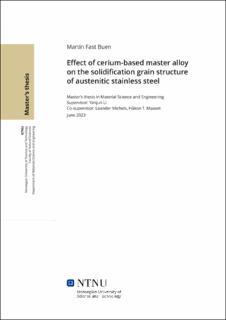| dc.contributor.advisor | Li, Yanjun | |
| dc.contributor.author | Fast Buen, Martin | |
| dc.date.accessioned | 2023-10-07T17:20:07Z | |
| dc.date.available | 2023-10-07T17:20:07Z | |
| dc.date.issued | 2023 | |
| dc.identifier | no.ntnu:inspera:140608939:35267280 | |
| dc.identifier.uri | https://hdl.handle.net/11250/3095082 | |
| dc.description.abstract | Følgende arbeid har studert effekten av en cerium-basert kornforfiner på størkningstrukturen og mikropartikkel-populasjonen i et austenittisk rustfritt stål. Termisk anlayse kopper og større Y-blokk profiler har blitt analysert med hjelp av lysmikroskopi, SEM/EDX, AMICS og EBSD. Den kommersielt tilgjengelige Elkem Grain Refiner(EGR) Stainseed har blitt brukt til dette formålet. Utgangsstålet for studien var et 316L austenittisk rustfritt stål produsert som en del av et pilotskala smelteforsøk. Som et høyt reaktivt sjelden-jordart element, vil cerium danne stabile partikler når det blir tilsatt stålsmelten. Disse partiklene, som inkluder oksider, aluminater, sulfider og oksysulfider, kan opptre som lokasjoner hvor hetereogen kimdanning av austenitt korn kan initieres. Effekten av EGR tilsats på størkningstrukturen ble studert i detalj. I tilegg ble en karakterisasjon av ikke-metalliske parikler og intermetalliske faser utført. Mikropartikkel populasjoner ble hentet og analysert ved hjelp av AMICS og ImageJ analyse. EGR tilsats viste en forfinende effekt på den kolumnære karakteristikken og kornstørrelsen til stålet. Den sekundære dendrittarm avstanden ble redusert med 27% og den gjennomsnittelige kornstørrelsen ble redusert med opptil 36% med tilsats av EGR. Cerium partiklene som opptredde oftest i denne studien var , CeAlO3 og CeO2. Tilsats av EGR viste også en total eliminasjon Al2O3 partikler, og førte til en reduksjon av intermetalliske faser i stålet. | |
| dc.description.abstract | The present work has studied the effect of a cerium-based grain refiner on the solidification structure and microparticle population in austenitic stainless steel. Smaller thermal analysis cups and larger Y-block underwent analysis in the form of LOM, SEM/EDX, AMICS, and EBSD. The developed and commercially available Elkem Grain Refiner(EGR) Stainseed was chosen for this purpose. The
base steel for the study was a 316L austenitic stainless steel produced at Elkem, Kristiansand, in a pilot scale casting trial. As a highly reactive rare-earth element, cerium forms stable inclusions when added to the steel melt. These inclusions, cerium oxides, sulfides, aluminates, and oxysulphides, may act as nucleation sites for austenite grains. The effect of EGR addition on the solidification structure was studied in detail, in addition to a characterization of the non-metallic particles and intermetallic phases formed during solidification. Microparticle populations were acquired through AMICS and ImageJ analysis. EGR addition showed a refining effect on the solidification structure of the steel. Significant refinement of the columnar characteristics and grain size was observed. The secondary dendrite arm spacing was reduced by 27%, and the average grain size was reduced by up to 36% by adding EGR. The most frequent cerium inclusions observed in this work were CeAlO3 and CeO2$. The addition of EGR was also found to completely remove the presence of Al2O3 and, furthermore, reduced the number of intermetallic phases in the steel. | |
| dc.language | eng | |
| dc.publisher | NTNU | |
| dc.title | Effect of cerium-based master alloy on the solidification grain structure of austenitic stainless steel | |
| dc.type | Master thesis | |
